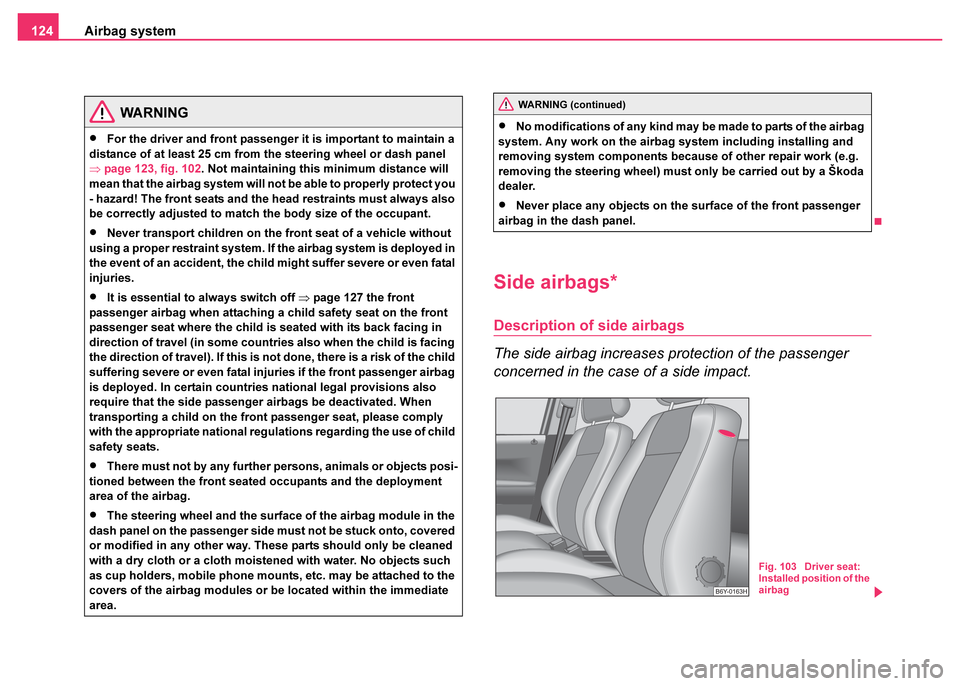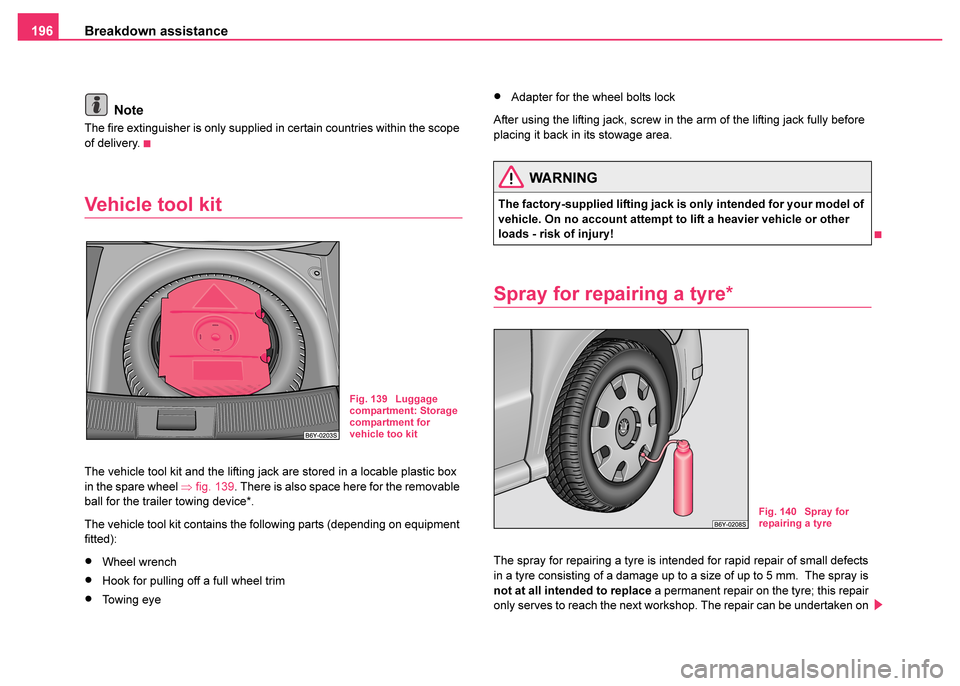2003 SKODA FABIA wheel size
[x] Cancel search: wheel sizePage 64 of 233

Seats and Stowage63
Using the systemSafetyDriving TipsGeneral MaintenanceBreakdown assist-
anceTechnical DataFabia Praktik
Seats and Stowage
Front seats
Basic information
The front seats have a wide range of different settings and can thus be
matched to the physical characteristics of the driver and front passenger.
Correct adjustment of the seats is particularly important for
•safely and quickly reaching the controls,
•a relaxed, fatigue-free body position,
•achieving the maximum protection offered by the seat belts and
the airbag system.
The chapters which follow describe the procedure which you should adopt
for adjusting the seats.
Adjusting the front seats
Adjusting a seat in a forward/back direction
– Pull the lever ⇒fig. 43 up and push the seat into the
desired position.
WARNING
•Always keep your feet in the footwell when the car is being
driven - never place your feet on the instrument panel or on the
surfaces of the seats. This is particularly important for the front
seat passenger. You will be exposed to increased risk of injury if it
becomes necessary to apply the brake or in the event of an acci-
dent.
•It is important for the driver and front passenger to maintain a
distance of at least 25 cm from the steering wheel or dash panel.
Not maintaining this minimum distance will mean that the airbag
system will not be able to properly protect you - hazard! The front
seats and the head restraints must always also be correctly
adjusted to match the body size of the occupant.
WARNING (continued)
•Ensure that there are no objects in the footwell as any objects
may get behind the pedals during a driving or braking manoeuvre.
You would then no longer be able to operate the clutch, to brake or
accelerate.
Fig. 43 Controls for
adjusting the seat
A1
Page 125 of 233

Airbag system
124
Side airbags*
Description of side airbags
The side airbag increases protection of the passenger
concerned in the case of a side impact.
WARNING
•For the driver and front passenger it is important to maintain a
distance of at least 25 cm from the steering wheel or dash panel
⇒ page 123, fig. 102 . Not maintaining this minimum distance will
mean that the airbag system will not be able to properly protect you
- hazard! The front seats and the head restraints must always also
be correctly adjusted to match the body size of the occupant.
•Never transport children on the front seat of a vehicle without
using a proper restraint system. If the airbag system is deployed in
the event of an accident, the child might suffer severe or even fatal
injuries.
•It is essential to always switch off ⇒page 127 the front
passenger airbag when attaching a child safety seat on the front
passenger seat where the child is seated with its back facing in
direction of travel (in some countries also when the child is facing
the direction of travel). If this is not done, there is a risk of the child
suffering severe or even fatal injuries if the front passenger airbag
is deployed. In certain countries national legal provisions also
require that the side passenger airbags be deactivated. When
transporting a child on the front passenger seat, please comply
with the appropriate national regulations regarding the use of child
safety seats.
•There must not by any further persons, animals or objects posi-
tioned between the front seated occupants and the deployment
area of the airbag.
•The steering wheel and the surface of the airbag module in the
dash panel on the passenger side must not be stuck onto, covered
or modified in any other way. These parts should only be cleaned
with a dry cloth or a cloth moistened with water. No objects such
as cup holders, mobile phone mounts, etc. may be attached to the
covers of the airbag modules or be located within the immediate
area.
WARNING (continued)
•No modifications of any kind may be made to parts of the airbag
system. Any work on the airbag system including installing and
removing system components because of other repair work (e.g.
removing the steering wheel) must only be carried out by a Škoda
dealer.
•Never place any objects on the surface of the front passenger
airbag in the dash panel.
Fig. 103 Driver seat:
Installed position of the
airbag
Page 191 of 233

Wheels and Tyres
190
Škoda Auto. They are exactly matched to the vehicle type and therefore
contribute significantly to good road holding and safe driving characteris-
tics ⇒ .
Only fit radial tyres of the same type on all 4 wheels of the same type, size
(rolling circumference) and, if possible, the same tread pattern.
Skoda dealers have access to the most current information about which
tyres we have released for use.
We recommend that you have any work relating to tyres or wheels carried
out by your Škoda dealer . Your dealer has all of the necessary special
tools and replacement parts available plus the required specialist knowl-
edge and is also in a position to properly dispose of the old tyres. A large
number of Škoda dealers also have an attractive range of tyres and
wheels available.
The tyre/wheel combinations which are approved for your vehicle are indi-
cated in your vehicle documents. Approval and licensing may differ
according to the legislation prevailing in individual countries.
Proper knowledge of the tyre data makes it easier for you to select the
correct type of tyre. Tyres do, for example, have the following inscription
on their walls:
185 / 60 R 14 82 T
What this means is: The following speed restrictions
apply to tyres.
The date of manufacture is also stated on the tyre wall (possibly only on
the inside of wheel):
DOT ... 30 01...
means, for example, that the tyre was manufactured in the 30th week of
the year 2001.
Any spare wheel which differs from the tyres fitted to the vehicle (e.g.
winter tyres or low-profile tyres) should only be used only for a short time
in the event of a puncture and when adopting an appropriately cautious
style of driving. It should be replaced as quickly as possible by a normal
wheel.
185Tyre width in mm
60Height/width ratio in %
RCode letter for the type of tyre - Radial
14Diameter of wheel in inches
82Load index
TSpeed symbol
Speed symbolPermissible maximum speed
Q160 km/h
R170 km/h
S180 km/h
T190 km/h
H210 km/h
V240 km/h
W270 km/h
WARNING
•Only use those tyres or wheel rims which have been approved
for your model of Škoda Auto vehicle. Failure to observe this
instruction will adversely affect the road safety of your vehicle -
risk of accident! Approval and licencing of your vehicle on public
roads may also become void as a result.
Page 192 of 233

Wheels and Tyres191
Using the systemSafetyDriving TipsGeneral MaintenanceBreakdown assist-
anceTechnical DataFabia Praktik
For the sake of the environment
Old tyres must be disposed of in conformity with the appropriate regula-
tions.
Note
It is not normally possible to fit wheels from other models of cars for tech-
nical reasons. This may also apply in certain circumstances to the wheels
of the same type of vehicle.
Wheel bolts
Wheels and wheel bolts are matched to each other in terms of design.
Each time you fit other wheels - e.g. light alloy wheels or wheels with
winter tyres - you must therefore also use the matching wheel bolts of the correct length and shape of spherical cap. This is essential to ensure that
the wheels are tightly fitted and that the brake system operates properly.
If you retrofit
wheel trims (or have this done), please also ensure that an
adequate flow of air remains assured for cooling the brake system.
Škoda dealers are instructed in the technical possibilities which exist
regarding converting or retrofitting wheels, tyres and wheel trim.
The wheel bolts must be clean and must turn easily.
Winter tyres
The handling of your vehicle will be significantly improved when driving on
wintry roads and at temperatures below 7 °C if you fit winter tyres.
Summer tyres do not offer the same grip on ice and snow because of their
construction (width, rubber blend, tread pattern). This particularly applies
to vehicles which are equipped with low-profile tyres or high-speed
tyres (code index V or W on wall of tyre).
Winter tyres must be mounted on all four wheels to obtain the best
handling characteristics.
Only use radial winter tyres.
You must only fit those types of winter tyre which are approved for your
vehicle. The permissible sizes of winter tyres are stated in your vehicle
documents. Approvals may differ because of national legislation.
Please remember that the tyres should be inflated to 0.2 bar more than is
the case for summer tyres ⇒page 187.
Winter tyres no longer offer the same winter performance once the tyre
tread has worn down to a depth of about 4 mm.
Ageing also causes winter tyres to lose most of their winter performance
properties - even in cases where the remaining tread depth is still clearly
more than 4 mm.
WARNING (continued)
•You must on no account drive at a higher speed than is permis-
sible for your tyres - risk of an accident resulting from tyre damage
and loss of control over your vehicle.
•Tyres which are 6 years old or more should only be fitted in
exceptional cases and when adopting an appropriately cautious
style of driving.
•Never fit tyres which have already been used without having
adequate knowledge of their previous history. Tyres age even if
they have not been used at all or only very little. A spare tyre must
only be used in exceptional cases and only then when adopting an
appropriately cautious style of driving.
•Do not, where possible, replace individual tyres but at least
replace them on both wheels of a given axle at the same time.
Always fit the tyres with the deeper tread depth to the front wheels.
Page 197 of 233

Breakdown assistance
196
Note
The fire extinguisher is only supplied in certain countries within the scope
of delivery.
Vehicle tool kit
The vehicle tool kit and the lifting jack are stored in a locable plastic box
in the spare wheel ⇒ fig. 139. There is also space here for the removable
ball for the trailer towing device*.
The vehicle tool kit contains the following parts (depending on equipment
fitted):
•Wheel wrench
•Hook for pulling off a full wheel trim
•To w i n g e y e
•Adapter for the wheel bolts lock
After using the lifting jack, screw in the arm of the lifting jack fully before
placing it back in its stowage area.
Spray for repairing a tyre*
The spray for repairing a tyre is intended for rapid repair of small defects
in a tyre consisting of a damage up to a size of up to 5 mm. The spray is
not at all intended to replace a permanent repair on the tyre; this repair
only serves to reach the next workshop. The repair can be undertaken on
Fig. 139 Luggage
compartment: Storage
compartment for
vehicle too kit
WARNING
The factory-supplied lifting jack is only intended for your model of
vehicle. On no account attempt to lift a heavier vehicle or other
loads - risk of injury!
Fig. 140 Spray for
repairing a tyre